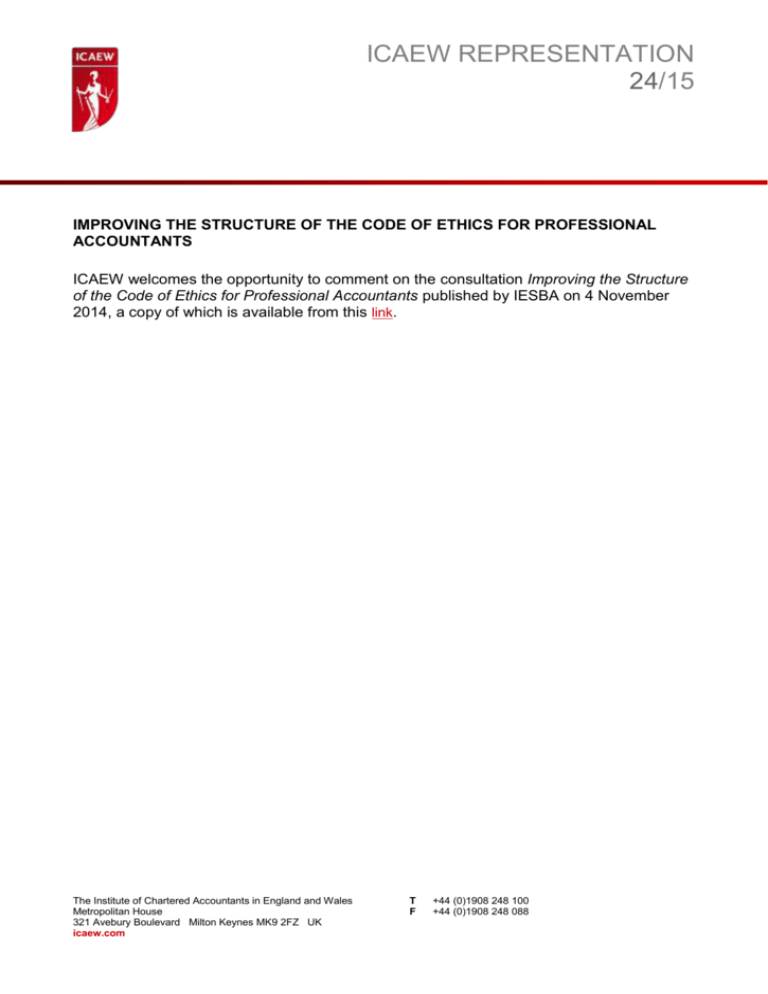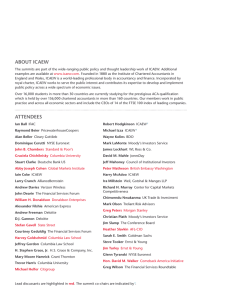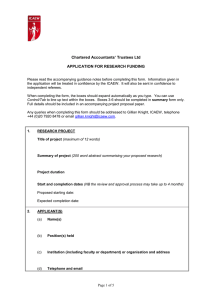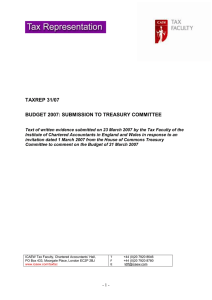
ICAEW REPRESENTATION
24/15
IMPROVING THE STRUCTURE OF THE CODE OF ETHICS FOR PROFESSIONAL
ACCOUNTANTS
ICAEW welcomes the opportunity to comment on the consultation Improving the Structure
of the Code of Ethics for Professional Accountants published by IESBA on 4 November
2014, a copy of which is available from this link.
The Institute of Chartered Accountants in England and Wales
Metropolitan House
321 Avebury Boulevard Milton Keynes MK9 2FZ UK
icaew.com
T
F
+44 (0)1908 248 100
+44 (0)1908 248 088
ICAEW is a world-leading professional accountancy body. We operate under a Royal Charter,
working in the public interest. ICAEW’s regulation of its members, in particular its responsibilities in
respect of auditors, is overseen by the UK Financial Reporting Council. We provide leadership and
practical support to over 142,000 member chartered accountants in more than 160 countries,
working with governments, regulators and industry in order to ensure that the highest standards
are maintained.
ICAEW members operate across a wide range of areas in business, practice and the public sector.
They provide financial expertise and guidance based on the highest professional, technical and
ethical standards. They are trained to provide clarity and apply rigour, and so help create long-term
sustainable economic value.
Copyright © ICAEW 2015
All rights reserved.
This document may be reproduced without specific permission, in whole or part, free of charge and
in any format or medium, subject to the conditions that:
it is appropriately attributed, replicated accurately and is not used in a misleading context;
the source of the extract or document is acknowledged and the title and ICAEW reference
number are quoted.
Where third-party copyright material has been identified application for permission must be made to
the copyright holder.
For more information, please contact: representations@icaew.com
icaew.com
2
ICAEW representation 24/15 Improving the Structure of the Code of Ethics For Professional Accountants
MAJOR POINTS
1. We are supportive of the project and the general thrust of the approach proposed in the
consultation paper. We do have some concerns about some of the rationale and detail. These
are summarised in the responses to the relevant questions but the key issues are:
The enforceability of the code, and the ease by which it can be translated into law and
regulation should not be a primary measure of success. The expectation is of a higher
standard of behaviour and a different approach to decision making.
We should not allow the lines between compliant behaviour and ethical behaviour to
become blurred. This may also be an unfortunate by product of rebranding the code as a
standard.
In determining responsibility for ethics it is important that we do not create a backdrop that
allows for ‘gaps’ in ethical responsibility such as abdication of collective responsibility and
scapegoating.
IESBA should avoid the temptation to commit to an overly ambitious timetable.
RESPONSES TO SPECIFIC QUESTIONS
Q1: Do you believe that the approach outlined in this Consultation Paper, as reflected in the
Illustrative Examples, would be likely to achieve IESBA’s objective of making the Code
more understandable? If not, why not and what other approaches might be taken?
2. We welcome the commitment to make the code more understandable and aid ease of
navigation. We are particularly keen that emphasis on the principles based approach is
maintained and clear, and that the threats and safeguards approach can be easily drawn out of
the ‘requirements’ sections. It should also be clear from the ‘Purpose’ paragraphs what each
section is trying to achieve i.e. what the substance of the requirements is.
3. We support the desire to distinguish requirements from wider guidance. It is unhelpful if various
requirements that relate to the same issue are found in different locations. IESBA should
consider presenting all prohibitions at the beginning of the ‘requirements’ sections, these being
the provisions accountants are most likely to need to refer to continually.
4. We are concerned that some of the application and other explanatory material could hinder
navigation and understanding. If the requirements are to be made clearer then the content in
these sections could be reduced. This might also help avoid unnecessary repetition of certain
material and limit overlap and confusion. For example, 100.010 says that “A professional
accountant may be required to resolve a conflict”, but after re-ordering, we know that if there is
such a conflict, the accountant must resolve it. It may therefore be possible that some of the
background material could be included as a foreword to the code, particularly where it does not
directly relate to the requirements.
5. A clearer distinction between practical application guidance and further explanation of the
requirements would be beneficial. There is a risk that everything that is not ‘requirement’ might
be ignored, and clearly separating out the more practical application guidance from the further
explanatory material will not only mitigate this risk but also enhance the usefulness of the code.
Q2: Do you believe that the approach outlined in this Consultation Paper, as reflected in the
Illustrative Examples would be likely to make the Code more capable of being adopted into
laws and regulations, effectively implemented and consistently applied? If not, why not and
what other approaches might be taken?
3
ICAEW representation 24/15 Improving the Structure of the Code of Ethics For Professional Accountants
6. We believe that distinguishing requirements from other guidance will make the Code easier to
adopt into law and regulations, and in doing so facilitate enforcement by regulators. However,
the Code should be about setting out the right behaviour by professional accountants in the
public interest: we are not convinced that ease of enforceability should be a primary purpose of
the restructuring.
7. The language and structure of a principles based code by its very nature will not always
translate easily into law and regulation. However, this should not necessarily be a measure of
success as the expectation is of a higher standard of behaviour and a different approach to
decision making.
8. Furthermore different countries will face their own unique challenges in trying to incorporate an
international Code into law and regulations.
9. That being said, one area where this may be a desirable objective is independence. There may
therefore be an argument for a separate independence section containing all independence
requirements (including elements of the current part A and section 200) in one place.
Q3: Do you have any comments on the suggestions as to the numbering and ordering of
the content of the Code (including reversing the order of extant Part B and Part C), as set
out in paragraph 20 of the Consultation Paper?
10. We are supportive of placing the independence material in separate sections. In particular we
believe it would be helpful to split s290 into several sections as changes can result in
excessively disruptive renumbering at present.
11. We are also supportive of reversing the order of extant Part B and Part C for the reasons
explained in the paper.
Q4: Do you believe that issuing the provisions in the Code as separate standards or
rebranding the Code, for example as International Standards on Ethics, would achieve
benefits such as improving the visibility or enforceability of the Code?
12. The lines between principles of behaviour and enforceable standards should not become
blurred. Guidance on ethical conduct is primarily about an attitude of mind rather than
procedures. It is therefore suited to a principles based code. Re-branding the Code as a
standard runs the risk of appearing to move towards a rules-based approach and therefore a
tick the box ‘compliance’ mentality. We are not convinced by the arguments advanced in the
paper, as it is not clear to us that the Code currently suffers from its title in terms of application.
‘Code’ is also a standard term amongst professional bodies.
13. The ethical requirements addressed in the fundamental principles should not be framed in
terms of their enforceability as this could result in behaviour becoming focussed on mere
“legalistic” compliance.
14. There is some benefit to transparency for the Code to be split into a number of separate
documents to facilitate small changes and the publicity thereof.
15. There may also be benefit in publishing separate independence standards for audit and review
engagements.
Q5: Do you believe that the suggestions as to use of language, as reflected in the
Illustrative Examples, are helpful? If not, why not?
16. We support the proposals regarding use of language.
17. However, we think it important to ensure that stakeholders are comfortable with phrases
currently used. For example, the UK Financial Reporting Council, rightly in our view, has
expunged references to ‘audit client’ as this gives a false message about the relationship
between auditor and the entity being audited.
4
ICAEW representation 24/15 Improving the Structure of the Code of Ethics For Professional Accountants
Q6: Do you consider it is necessary to clarify responsibility in the Code? If so, do you
consider that the illustrative approach to responsibility is an appropriate means to enhance
the usability and enforceability of the Code? If not, what other approach would you
recommend?
18. We agree that it is helpful to clarify responsibility in the Code to the extent that a firm should
have a mechanism for allocating responsibility. However the draft wording could be interpreted
to imply that a specific person would take on the whole responsibility on behalf of the firm,
which we do not believe is intended, nor is it desirable or practical.
19. In determining responsibilities for various requirements, it is important that those responsible
for doing so avoid an abdication of individual responsibility for ethical behaviour. However it is
not the role of the Code to create scapegoats should regulatory intervention be required.
Collective responsibility at a senior level should be emphasised, as well as ensuring that there
are no ‘gaps’ in responsibility.
20. It would be impractical for an international code to go further than what we believe is intended
and be itself specific as to who should do what regardless of the circumstances, as those
circumstances in each organisation will be too variable.
Q7: Do you find the examples of responsible individuals illustrated in paragraph 33 useful?
21. The examples reflect the intent that different people might be responsible for different things. In
that sense they are useful, though they could arguably be included in an FAQ or off-Code
guidance.
Q8: Do you have any comments on the suggestions for an electronic version of the Code,
including which aspects might be particularly helpful in practice?
22. We are supportive of the introduction of an electronic code but it will need to be clear which the
official version is. If it is to be the electronic version this will make it easier for member bodies
that adopt a largely unadulterated version of the Code, in English. However such usage may
be limited: there is great potential for discrepancies arising between the IESBA Code and
member body codes due to the varying time lags resulting from individual update processes for
various reasons.
23. That said, a properly linked version is a useful reference tool, and may encourage many bodies
to adopt the code directly.
24. A filtered version (showing requirements for particular types of accountant or type of work)
would add to the usefulness.
25. In terms of the cross-referencing, it would be helpful to move the cross references, making it
clearer to what they relate. For example the cross reference at the end of 100.005 relates to
the whole paragraph not just section (e), but it appears at the end of (e). The destination cross
reference could appear against the relevant sub-heading to allow it to be quickly identified.
26. These points may be less problematic in an easily navigable electronic version.
Q9: Do you have any comments on the indicative timeline described in Section VIII of this
Paper?
27. We would urge IESBA to co-ordinate timing of the restructuring of the Code and other projects.
It is unhelpful for member bodies and their members to have to change the code frequently
with other revisions to the existing version before this restructuring is finalised.
28. The indicative timeline appears ambitious. It would be better that the exposure draft showing
the restructure included all likely changes, even if this means a deferral for some months.
5
ICAEW representation 24/15 Improving the Structure of the Code of Ethics For Professional Accountants
Q10: Do you have any other comments on the matters set out in the Consultation Paper?
29. While clarity as to defined, described, and section specific uses of wording are welcome, the
distinction between ‘defined’ and ‘described’ words seems over complex.
6












